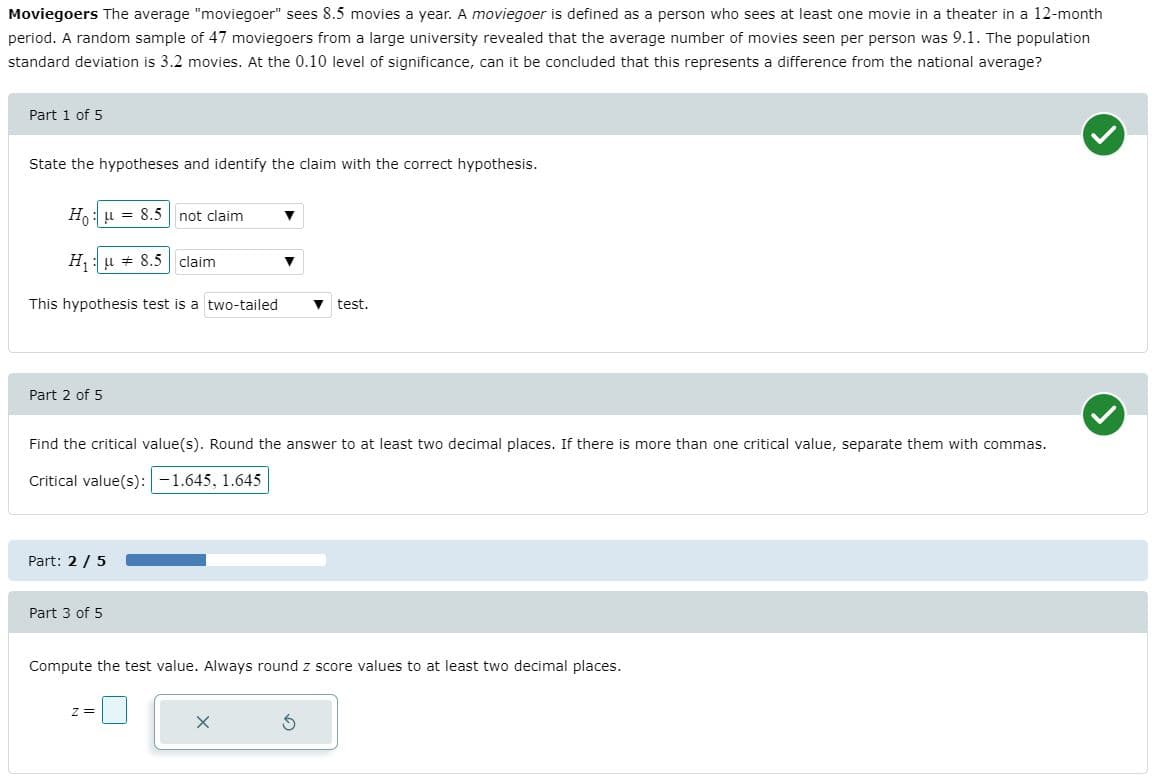Moviegoers The average "moviegoer" sees 8.5 movies a year. A moviegoer is defined as a person who sees at least one movie in a theater in a 12-month period. A random sample of 47 moviegoers from a large university revealed that the average number of movies seen per person was 9.1. The population standard deviation is 3.2 movies. At the 0.10 level of significance, can it be concluded that this represents a difference from the national average? Part 1 of 5 State the hypotheses and identify the claim with the correct hypothesis. Ho: u = 8.5 not claim H, : u + 8.5 claim This hypothesis test is a two-tailed v test. Part 2 of 5 Find the critical value(s). Round the answer to at least two decimal places. If there is more than one critical value, separate them with commas. Critical value(s): -1.645, 1.645 Part: 2 /5 Part 3 of 5 Compute the test value. Always round z score values to at least two decimal places.
Moviegoers The average "moviegoer" sees 8.5 movies a year. A moviegoer is defined as a person who sees at least one movie in a theater in a 12-month period. A random sample of 47 moviegoers from a large university revealed that the average number of movies seen per person was 9.1. The population standard deviation is 3.2 movies. At the 0.10 level of significance, can it be concluded that this represents a difference from the national average? Part 1 of 5 State the hypotheses and identify the claim with the correct hypothesis. Ho: u = 8.5 not claim H, : u + 8.5 claim This hypothesis test is a two-tailed v test. Part 2 of 5 Find the critical value(s). Round the answer to at least two decimal places. If there is more than one critical value, separate them with commas. Critical value(s): -1.645, 1.645 Part: 2 /5 Part 3 of 5 Compute the test value. Always round z score values to at least two decimal places.
Glencoe Algebra 1, Student Edition, 9780079039897, 0079039898, 2018
18th Edition
ISBN:9780079039897
Author:Carter
Publisher:Carter
Chapter10: Statistics
Section10.4: Distributions Of Data
Problem 19PFA
Related questions
Topic Video
Question

Transcribed Image Text:Moviegoers The average "moviegoer" sees 8.5 movies a year. A moviegoer is defined as a person who sees at least one movie in a theater in a 12-month
period. A random sample of 47 moviegoers from a large university revealed that the average number of movies seen per person was 9.1. The population
standard deviation is 3.2 movies. At the 0.10 level of significance, can it be concluded that this represents a difference from the national average?
Part 1 of 5
State the hypotheses and identify the claim with the correct hypothesis.
H: u = 8.5 not claim
H, : u + 8.5 claim
This hypothesis test is a two-tailed
test.
Part 2 of 5
Find the critical value(s). Round the answer to at least two decimal places. If there is more than one critical value, separate them with commas.
Critical value(s):-1.645, 1.645
Part: 2 /5
Part 3 of 5
Compute the test value. Always round z score values to at least two decimal places.
Expert Solution
This question has been solved!
Explore an expertly crafted, step-by-step solution for a thorough understanding of key concepts.
This is a popular solution!
Trending now
This is a popular solution!
Step by step
Solved in 2 steps

Knowledge Booster
Learn more about
Need a deep-dive on the concept behind this application? Look no further. Learn more about this topic, statistics and related others by exploring similar questions and additional content below.Recommended textbooks for you

Glencoe Algebra 1, Student Edition, 9780079039897…
Algebra
ISBN:
9780079039897
Author:
Carter
Publisher:
McGraw Hill

Glencoe Algebra 1, Student Edition, 9780079039897…
Algebra
ISBN:
9780079039897
Author:
Carter
Publisher:
McGraw Hill